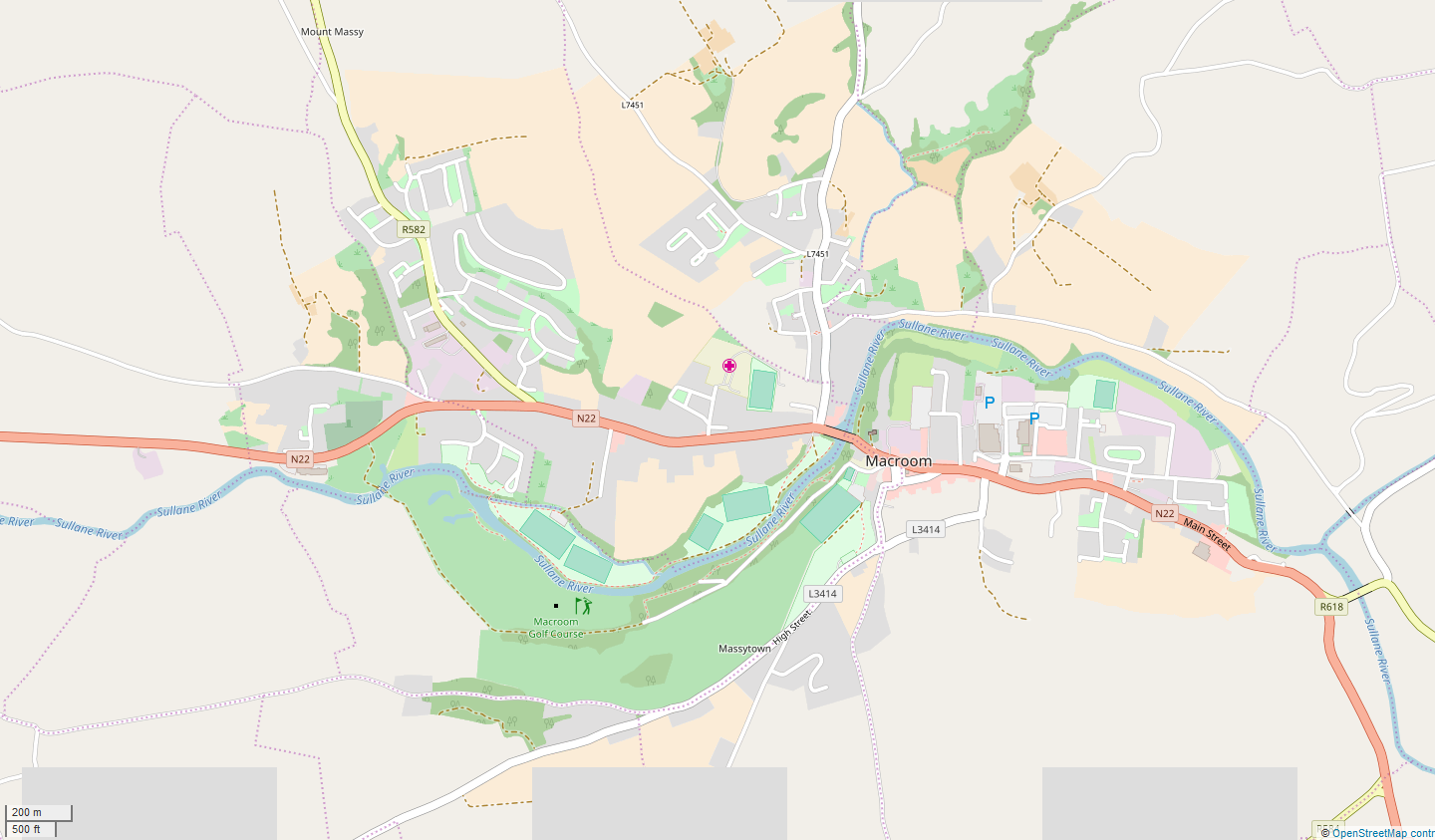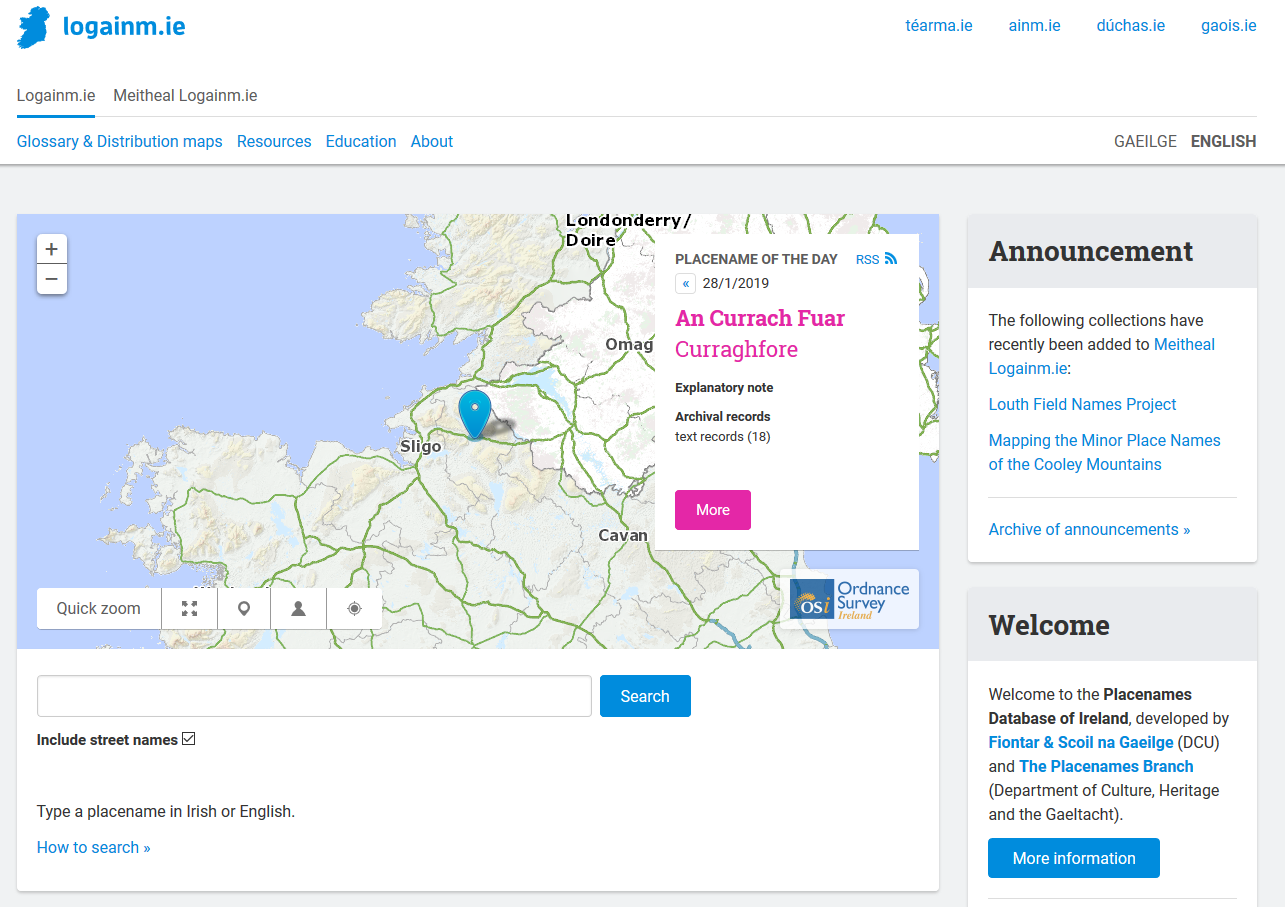|
Macroom
Macroom (; ) is a market town in County Cork, Ireland, located in the valley of the River Sullane, halfway between Cork (city), Cork city and Killarney. Its population has grown and receded over the centuries as it went through periods of war, famine and workhouses, forced emigration and intermittent prosperity. The 2011 census of Ireland, 2011 census gave an urban population of 3,879 people, while the 2016 census of Ireland, 2016 census recorded 3,765 people. The town is in a Civil parishes in Ireland, civil parish of the same name. Macroom began as a meeting place for the druids of Munster. It is first mentioned is in 6th-century records, and the immediate area hosted a major battle involving the Irish king Brian Boru. During the Middle Ages, the town was invaded by a succession of warring clans, including the Murcheatach Uí Briain and Richard de Cogan families. In the early modern period the MacCarthys took control and later the area found prosperity via milling. The MacCa ... [...More Info...] [...Related Items...] OR: [Wikipedia] [Google] [Baidu] |
River Sullane
The River Sullane () runs from the mountains between County Cork and County Kerry in southern Ireland, near the village of Cúil Aodha. After passing Ballyvourney, it runs through the centre of Macroom, to which it provides drinking water (and occasionally floods). The Sullane is joined by the River Bohill at Ballyvourney, the River Foherish at Clondrohid, about 5 kilometres west of Macroom and the River Launa locally known as "The Launey" one kilometre east of the town. The Sullane joins the River Lee a further kilometre east. The river is well stocked with trout, and also contains European perch (200 g average), minnow Minnow is the common name for a number of species of small freshwater fish, belonging to several genus, genera of the family Cyprinidae and in particular the subfamily Leuciscinae. They are also known in Ireland as wikt:pinkeen, pinkeens. While ... and a small number of pike. In 2024, effluent released from the Macroom Wastewater Treatment Plant polluted ... [...More Info...] [...Related Items...] OR: [Wikipedia] [Google] [Baidu] |
Carrigaphooca Castle
Carrigaphooca Castle ( meaning "castle on the rock of the fairy"; the word ''púca'' translates as ghost or fairy) is a ruined five storey rectangular tower house situated on a steep-sided rock overlooking the River Sullane. Carrigaphooca 6 km west of Macroom, County Cork, Ireland, in an area once known as Gleann na n-Dearg ("valley of the reds"). The tower dominates the landscape of Lissacresig (''Fairyland'') in Clondrohid, and Lower Shanballyshane, in Kilnamartyra. Carrigaphooca is made of sandstone and limestone and was built as a defensive tower by the MacCarthys of Muskerry in the early 15th century. Carrigaphooca is positioned in an area rich with Neolithic monuments; Carrigaphooca Stone Circle lies two fields to the east, with a large standing stone (gallán) to the west. The tower is located on private property, and is no longer accessible to the public, although it is owned by the state and maintained by the Office of Public Works. History Although named as a c ... [...More Info...] [...Related Items...] OR: [Wikipedia] [Google] [Baidu] |
Eircode
A postal address in Ireland is a place of Delivery (commerce), delivery defined by Irish Standard (IS) EN 14142-1:2011 ("Postal services. Address databases") and serviced by the universal service provider, . Its addressing guides comply with the guidelines of the Universal Postal Union (UPU), the United Nations-affiliated body responsible for promoting standards in the postal industry, across the world. In Ireland, 35% of premises (over 600,000) have non-unique addresses due to an absence of house numbers or names. Before the introduction of a national postcode system (Eircode) in 2015, this required postal workers to remember which family names corresponded to which house in smaller towns, and many townlands. , An Post encourages customers to use Eircode because it ensures that their post person can pinpoint the exact location. Ireland was the last country in the OECD to create a postcode system. In July 2015 all 2.2 million residential and business addresses in Ireland r ... [...More Info...] [...Related Items...] OR: [Wikipedia] [Google] [Baidu] |
Cork (city)
Cork ( ; from , meaning 'marsh') is the second-largest city in Republic of Ireland, Ireland, the county town of County Cork, the largest city in the Provinces of Ireland, province of Munster and the List of settlements on the island of Ireland by population, third largest on the island of Ireland. At the 2022 census of Ireland, 2022 census, it had a population of 224,004. The city centre is an island between two channels of the River Lee (Ireland), River Lee which meet downstream at its eastern end, where the quays and Dock (maritime), docks along the river lead outwards towards Lough Mahon and Cork Harbour, one of the largest natural harbours in the world. Cork was founded in the 6th century as a monastic settlement, and was expanded by Vikings, Viking invaders around 915. Its charter was granted by John, King of England, Prince John in 1185 in Ireland, 1185. Cork city was once fully walled, and the remnants of the old medieval town centre can be found around South and North M ... [...More Info...] [...Related Items...] OR: [Wikipedia] [Google] [Baidu] |
County Cork
County Cork () is the largest and the southernmost Counties of Ireland, county of Republic of Ireland, Ireland, named after the city of Cork (city), Cork, the state's second-largest city. It is in the Provinces of Ireland, province of Munster and the Southern Region, Ireland, Southern Region. Its largest market towns are Mallow, County Cork, Mallow, Macroom, Midleton, and Skibbereen. , the county had a population of 584,156, making it the third-List of Irish counties by population, most populous county in Ireland. Cork County Council is the Local government in the Republic of Ireland, local authority for the county, while Cork City Council governs the city of Cork and its environs. Notable Corkonians include Michael Collins (Irish leader), Michael Collins, Jack Lynch, Mother Jones, Roy Keane, Sonia O'Sullivan, Cillian Murphy and Graham Norton. Cork borders four other counties: County Kerry, Kerry to the west, County Limerick, Limerick to the north, County Tipperary, Tipperary ... [...More Info...] [...Related Items...] OR: [Wikipedia] [Google] [Baidu] |
Telephone Numbers In The Republic Of Ireland
Numbers on the Irish telephone numbering plan are regulated and assigned to operators by ComReg. Overview Telephone numbers in Ireland are part of an open numbering plan that allows variations in number length. The Irish format is similar to systems used in many parts of Europe, notably the Netherlands, Sweden, Germany, Belgium and France, where geographical numbers are organised using a logic of large regional prefixes, which are then further subdivided into smaller regions. It differs from UK numbering, which originated as alphanumeric codes based on town names. Irish Mobile and non–geographic numbers are fixed length and do not support local dialling. The trunk prefix 0 is used to access numbers outside the local area and for all mobile calls. This is followed by an area code, referred to as a National Dialling Code (NDC), the first digit of which indicates the geographical area or type of service (e.g. mobile). Calls made from mobile phones and some VoIP systems always ... [...More Info...] [...Related Items...] OR: [Wikipedia] [Google] [Baidu] |
Druid
A druid was a member of the high-ranking priestly class in ancient Celtic cultures. The druids were religious leaders as well as legal authorities, adjudicators, lorekeepers, medical professionals and political advisors. Druids left no written accounts. While they were reported to have been literate, they are believed to have been prevented by doctrine from recording their knowledge in written form. Their beliefs and practices are attested in some detail by their contemporaries from other cultures, such as the Romans and the Greeks. The earliest known references to the druids date to the 4th century BC. The oldest detailed description comes from Julius Caesar's ''Commentarii de Bello Gallico'' (50s BC). They were described by other Roman writers such as Cicero, Cicero (44) I.XVI.90. Tacitus, and Pliny the Elder. Following the Roman invasion of Gaul, the druid orders were suppressed by the Roman government under the 1st-century AD emperors Tiberius and Claudius, a ... [...More Info...] [...Related Items...] OR: [Wikipedia] [Google] [Baidu] |
Civil Parishes In Ireland
Civil parishes () are units of territory in the island of Ireland that have their origins in old Gaelic territorial divisions. They were adopted by the Anglo-Norman Lordship of Ireland and then by the Elizabethan Kingdom of Ireland, and were formalised as land divisions at the time of the Plantations of Ireland. They no longer correspond to the boundaries of Roman Catholic or Church of Ireland parishes, which are generally larger. Their use as administrative units was gradually replaced by Poor_law_union#Ireland, Poor Law Divisions in the 19th century, although they were not formally abolished. Today they are still sometimes used for legal purposes, such as to locate property in deeds of property registered between 1833 and 1946. Origins The Irish parish was based on the Gaelic territorial unit called a ''túath'' or ''Trícha cét''. Following the Norman invasion of Ireland, the Anglo-Normans, Anglo-Norman barons retained the ''tuath'', later renamed a parish or manor, as a un ... [...More Info...] [...Related Items...] OR: [Wikipedia] [Google] [Baidu] |
Placenames Database Of Ireland
The Placenames Database of Ireland (), also known as , is a database and archive of place names in Ireland. It was created by Fiontar, Dublin City University in collaboration with the Placenames Branch of the Department of Tourism, Culture, Arts, Gaeltacht, Sport and Media. The website is a public resource primarily aimed at journalists and translators, students and teachers, historians and researchers in genealogy. Placenames Commission and Placenames Branch The Placenames Commission () was established by the Department of Finance in 1946 to advise Ordnance Survey Ireland and the government of what the Irish name of places should be. Although both the 1922 Constitution of the Irish Free State and the current constitution adopted in 1937 recognised Irish as the national language, the law in regard to placenames was carried over from the 19th-century UK statutes which established the Ordnance Survey and Griffith's Valuation, under which only an English-language name had offi ... [...More Info...] [...Related Items...] OR: [Wikipedia] [Google] [Baidu] |
Bridge Over The Sullane, Macroom - Geograph
A bridge is a structure built to Span (engineering), span a physical obstacle (such as a body of water, valley, road, or railway) without blocking the path underneath. It is constructed for the purpose of providing passage over the obstacle, which is usually something that is otherwise difficult or impossible to cross. There are many different designs of bridges, each serving a particular purpose and applicable to different situations. Designs of bridges vary depending on factors such as the function of the bridge, the nature of the terrain where the bridge is constructed and anchored, the material used to make it, and the funds available to build it. The earliest bridges were likely made with fallen trees and stepping stones. The Neolithic people built boardwalk bridges across marshland. The Arkadiko Bridge, dating from the 13th century BC, in the Peloponnese is one of the oldest arch bridges in existence and use. Etymology The ''Oxford English Dictionary'' traces the origin of ... [...More Info...] [...Related Items...] OR: [Wikipedia] [Google] [Baidu] |







